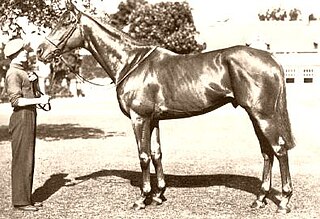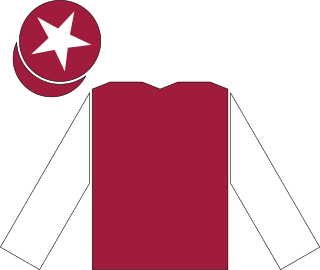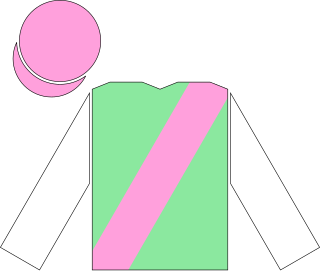Related Research Articles

Shaamit (1993–2001) was an Irish-bred, British-trained Thoroughbred race horse and sire. In a career which lasted from September 1995 to October 1996, he ran six times and won twice. He was the winner of the Epsom Derby in 1996. He was retired to stud at the end of his three-year-old season where he had limited success. He died in 2001.
Silver Patriarch was a racehorse, winner of the 1997 St Leger and of seven other races. He was ridden by Pat Eddery in all but three of his races.
Bustino was a British Thoroughbred racehorse and sire. In a career which lasted from August 1973 until July 1975, he ran nine times and won five races. He was the best British three-year-old of 1974, when his wins included the Classic St Leger, as well as the Sandown Classic Trial, Lingfield Derby Trial and Great Voltigeur Stakes. As a four-year-old he won the Coronation Cup in record time and finished second to Grundy in the King George VI and Queen Elizabeth Stakes in what is often described as the 'Race of the Century'.

Alycidon (1945–1963) was a British Thoroughbred racehorse who was described as "one of the greatest stayers in history". In a career which lasted from the autumn of 1947 until September 1949 he ran seventeen times and won eleven races. He was the second best British three-year-old of his generation, when he finished second to Black Tarquin in the St Leger Stakes. He was undefeated in his remaining seven races, defeating Black Tarquin in the 1949 Ascot Gold Cup and going on to win the Stayers' Triple Crown. After his retirement from racing he became the Leading sire in Great Britain & Ireland in 1955, despite having low fertility and a relatively short career at stud.

Commanche Run (1981–2005) was a British Thoroughbred racehorse. He was a versatile top-class colt who won a number of Group One races at from one and a quarter to one and three-quarter miles in the 1980s.

Shantou was a classic-winning Thoroughbred racehorse and sire. As a three-year-old in 1996 he won the St. Leger and the Gran Premio del Jockey Club as well as finishing third in the Epsom Derby and fourth in the Breeders' Cup Turf. In the following year he won the Gran Premio di Milano and the Princess of Wales's Stakes. After his retirement from racing he had success as a sire of National Hunt horses.
Celeric is a retired, British Thoroughbred racehorse. He improved from running in minor handicaps to Group One level, and recorded his most important win in the 1997 Ascot Gold Cup. In the same year he was named European Champion Stayer at the Cartier Racing Awards. He won thirteen of his forty-two races in a career which lasted from 1994 until his retirement at the age of eight in 2000. Together with Double Trigger, Kayf Tara and Persian Punch he was one of a group of horses credited with revitalising the staying division in the 1990s.

Fairway (1925–1948) was a British Thoroughbred racehorse and sire. Fairway was the best horse of his generation in Britain at two, three and four years old, winning the St Leger Stakes, the Champion Stakes (twice) and the Eclipse Stakes. He retired as a five-year-old in 1930 and went on to become a successful and influential sire.

Airborne was an Irish-bred British-trained Thoroughbred racehorse and sire. After showing little worthwhile form as a two-year-old, Airborne improved to become one of the leading three-year-olds in Britain in 1946. He won five successive races including two Classics: the Derby at Epsom and the St Leger at Doncaster. He was the most recent of four greys to have won the Epsom Classic. Airborne went on to have a stud career of limited success.
Tirol was an Irish-bred, British-trained Thoroughbred racehorse and sire. In a racing career that lasted from July 1989 to September 1990 he ran nine times in Britain, Ireland and France. Beginning in September 1989, he won five consecutive races, culminating the following spring with successes in the Classic 2000 Guineas at Newmarket and the Irish 2,000 Guineas at the Curragh. After two defeats later in 1990 Tirol was retired to stud, where he had some success as a sire of winners. He died in India in 2007.
Sixties Icon, is a retired British Thoroughbred racehorse and active sire. In a career which lasted from April 2006 until November 2008, he ran seventeen times and won eight races. He recorded his most important victory when winning the Classic St. Leger Stakes as a three-year-old. He won five other Group Races before being retired to stud.
Bollin Eric, was a British Thoroughbred racehorse and sire. In a career which lasted from July 2001 until October 2003, he ran eighteen times and won four races. He recorded his most important success when winning the Classic St. Leger Stakes as a three-year-old in 2002. He won the Lonsdale Stakes in the following year and was placed in important races including the Dante Stakes, King Edward VII Stakes, Great Voltigeur Stakes, Yorkshire Cup and Hardwicke Stakes.

Classic Cliche, was a Thoroughbred racehorse and active sire who was bred in Ireland and trained in Britain and the United Arab Emirates. In a career which lasted from August 1994 until September 1997, he ran sixteen times and won six races. He recorded his most important success when winning the Classic St. Leger Stakes as a three-year-old in 1995, the same year in which he won the Dante Stakes. In the following season he became the first Classic winner in fifty years to win the Ascot Gold Cup.

Toulon (1988–1998), was a Thoroughbred racehorse and sire who was bred in Britain and trained in France. In a career which lasted from October 1990 until October 1992, he ran eleven times and won four races. He recorded his most important success when winning the Classic St. Leger Stakes as a three-year-old in 1990, the same year in which he won the Chester Vase and the Prix Maurice de Nieuil as well as finishing fourth in the Prix de l'Arc de Triomphe. In the following season he failed to win in four races in Europe and had limited success when racing in California in 1993. He was then retired to stud, where he proved to be a successful sire of National Hunt horses.

Tracery (1909–1924) was an American-bred, British-trained Thoroughbred racehorse and sire, best known for winning the St. Leger Stakes in 1912. In a career which lasted from June 1912 until October 1913 he ran nine times and won six races. After finishing third on his debut in the 1912 Epsom Derby Tracery never lost another completed race at level weights. He won the St. James's Palace Stakes, Sussex Stakes and St. Leger Stakes in 1912 and the Eclipse Stakes and Champion Stakes as a four-year-old in 1913. He was brought down by a protester in the 1913 Ascot Gold Cup. After his retirement from racing he became a highly successful breeding stallion in Britain and Argentina.
English Prince (1971–1983) was an Irish-bred, British-trained Thoroughbred racehorse and sire. In a racing career which lasted four months in the spring and summer of 1974 he ran six times and won four races. After being beaten on his racecourse debut he won the White Rose Stakes, Predominate Stakes and King Edward VII Stakes in England before recording his most important success in the Irish Derby. He suffered from a series of training problems thereafter, was beaten by Bustino in his only subsequent race and was retired from racing at the end of the year. He sired the dual classic winner Sun Princess before being exported to Japan where he died in 1983.
Hycilla was a British Thoroughbred racehorse and broodmare, who raced during World War II and was best known for winning the classic Oaks Stakes in 1944. Unraced as a juvenile, she finished second on her three-year-old debut before winning the Oaks, which was run that year at Newmarket Racecourse. She was beaten when favourite for St Leger but ended her year with a win in the Champion Stakes. In the following year, she failed to win but ran well in defeat when third in a strongly-contested Coronation Cup. She retired to become a broodmare in the United States but made little impact, producing four minor stakes winners.

Saddlers' Hall was an Irish-bred, British-trained Thoroughbred racehorse and sire. After finishing fifth in his only race as a juvenile he developed into a high class staying colt in 1991, winning the King Edward VII Stakes and finishing second the St Leger. He reached his peak in the first half of the following season, winning four consecutive Group races: the John Porter Stakes, Ormonde Stakes, Coronation Cup and Princess of Wales's Stakes. He was retired to stud at the end of the year and had some success as a breeding stallion, siring the St Leger winner Silver Patriarch. He died in 2008 at the age of twenty.
Assessor was an Irish-bred, British-trained Thoroughbred racehorse and sire best known for his performances over extended distances. After winning two minor races as a juvenile developed into a high-class stayer in 1992, recording wins in the Lingfield Derby Trial and Prix Royal-Oak. He reached his peak as a four-year-old in 1993 when he won the Yorkshire Cup, Doncaster Cup and Prix du Cadran. He suffered from training problems thereafter but recorded another big win when he took the St Leger Italiano in 1995. After his retirement from racing he became a successful sire of National Hunt horses.
Subjectivist is a British Thoroughbred racehorse best known for his performances over extended distances. As a two-year-old he showed some promise, winning one minor race from seven attempts as well as finishing runner-up in the Listed Stonehenge Stakes. In the following year he won the Listed Glasgow Stakes, the Group 3 March Stakes as well as being placed in the King George V Stakes and the Gordon Stakes before ending his season with a Group 1 victory in the Prix Royal Oak. As a four-year-old he won the Dubai Gold Cup and the Ascot Gold Cup
References
- ↑ "Millenary pedigree". Racing Post. Retrieved 6 September 2011.
- ↑ "Millenary". Knockhouse Stud. Retrieved 6 September 2011.
- ↑ "Washington Singer Stakes". Racing Post. Retrieved 6 September 2011.
- ↑ "Peter Smith Memorial Maiden Stakes". Racing Post. Retrieved 6 September 2011.
- ↑ "Chester Vase". Racing Post. Retrieved 6 September 2011.
- ↑ "Chester: Millenary bags Vase" . Retrieved 6 September 2011– via The Free Library.
- ↑ Hannan, Martin. "Millenary sews up St Leger". The Scotsman. Retrieved 6 September 2011.
- ↑ Scott, Brough (10 September 2000). "Millenary toughs it out to take St Leger". Telegraph. London. Retrieved 28 August 2011.
- ↑ "Millenary Edges Air Marshall in St. Leger". BloodHorse. Retrieved 6 September 2011.
- ↑ "Jockey Club Stakes". Racing Post. Retrieved 6 September 2011.
- ↑ "Newmarket salutes Millenary". BBC News. 4 May 2001. Retrieved 6 September 2011.
- ↑ "Princess of Wales's Stakes 2002". Racing Post. Retrieved 6 September 2011.
- ↑ J A McGrath (10 July 2002). "Culhane's costly blunder". Telegraph. London. Retrieved 6 September 2011.
- ↑ "Prix Jean de Chaudenay". Racing Post. Retrieved 6 September 2011.
- ↑ "Loxias wins Prix Jean de Chaudenay by disqualification". Thoroughbred Times. 21 May 2003. Retrieved 6 September 2011.
- ↑ "Millenary Wins Princess of Wales's Again". BloodHorse. 8 July 2003. Retrieved 6 September 2011.
- ↑ "Princess of Wales's Stakes 2003". Racing Post. Retrieved 6 September 2011.
- ↑ Greg Wood at Newmarket (8 July 2003). "Millenary highlights a Classic crop crisis | Sport". The Guardian. London. Retrieved 6 September 2011.
- ↑ "Jockey Club Cup 2003". Racing Post. Retrieved 6 September 2011.
- ↑ "Millenary surges to Yorkshire Cup glory". RTÉ. 13 May 2004. Retrieved 28 August 2011.
- ↑ "BBC Sport | Other Sport | Horse Racing | Dead-heat in Doncaster Cup". BBC News. 9 September 2004. Retrieved 6 September 2011.
- ↑ "Racenews Newslink Archive – Saturday, October 16, 2004". Racenewsonline.co.uk. Retrieved 6 September 2011.
- ↑ "RTÉ Sport: Millenary achieves top marks". RTÉ. 16 August 2005. Retrieved 6 September 2011.
- ↑ Armytage, Marcus (9 September 2005). "Millenary turns back years". Telegraph. London. Retrieved 6 September 2011.
- ↑ "BLOODSTOCK DESK: Millenary". 9 November 2005. Retrieved 6 September 2011– via The Free Library.
- ↑ "EndMaterial2001.qxd" (PDF). Retrieved 6 September 2011.
- ↑ "2004Rankings". horseracingintfed.com. Retrieved 4 July 2012.
- ↑ "The 2005 World Thoroughbred Racehorse Rankings". International Federation of Horse Racing Authorities. 31 December 2005. Retrieved 6 September 2011.
- ↑ "Millenary". Knockhousestud.com. Retrieved 28 August 2011.
- ↑ "Millenary pedigree". Equineline. 8 May 2012. Retrieved 4 July 2012.
- ↑ Patricia Erigero Thoroughbred Heritage. "1 Tregonwell's Natural Barb Mare". Tbheritage.com. Retrieved 4 July 2012.